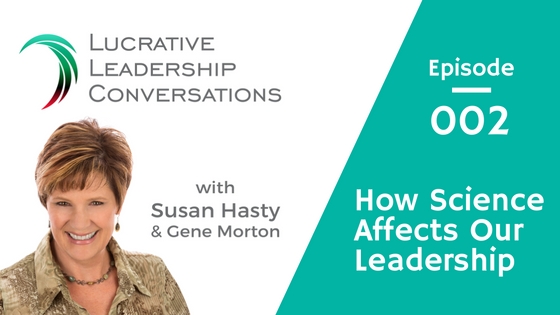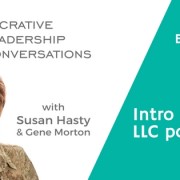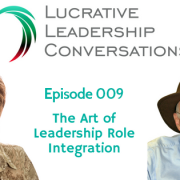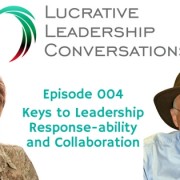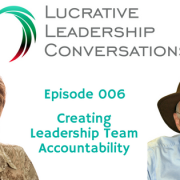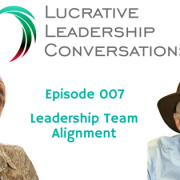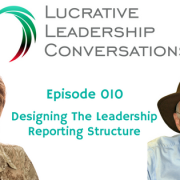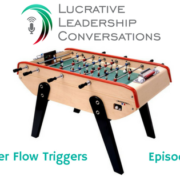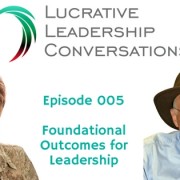002 | The Effect of Business Science on Our Leadership
After seven business ventures and over 35 years of experience, I have learned several critical elements to developing a sustainable business that remains profitable over time. One of these critical elements is relevant business science that impacts our conversations in leadership as managers, supervisors, and especially CEO’s.
Let’s look at 7 psychological factors of effective business science that have a direct influence on our leadership capacity. Once we are aware of these areas, we can determine both our strengths and shortcomings to guide us towards deeper and more effective leadership.
Business Science Factor #1: Cognitive Bias
In a Harvard Business Review article titled “Why we can’t see what’s right in front of us” Tony McCaffrey shares an interesting insight about the sinking of the Titanic on April 15th, 1912. Approximately 1500 people died in vain clamoring for the limited supply of lifeboats. All the while, right in front of them was an iceberg 50×100 feet high and 200×400 feet long. They overlooked the possibility the iceberg could have been their lifeboat.
Cognitive bias is the inability to think about or use an object in a way other than the way it is commonly used.
In today’s workforce, I see a major cognitive bias, or blind spot: Leaders who discount their employees’ insights on strategy.
Business Science Factor #2: Fixed Mindset vs. Growth Mindset
Carol Dweck is a Professor of Psychology at Stanford University. She graduated from Barnard College in 1967 and earned a Ph.D. from Yale University in 1972. As the author of Mindset, a classic on motivation, her work is influential among educators and increasingly among business leaders, as well.
She found that our success has to do with how we live into the future. A “fixed mindset” assumes that our character, intelligence, and creative ability are static or fixed unchangeable in any meaningful way.
A “growth mindset,” on the other hand, thrives on challenge and sees failure as a springboard for growth and for stretching our existing abilities. Not as evidence of unintelligence or failure.
Dweck found that a Growth Mindset creates a passion for learning rather than a hunger for approval. Its hallmark is the conviction that qualities like intelligence and creativity, and love and friendship, can be learned through effort and deliberate practice. Not only are people with this mindset not discouraged by failure, but they don’t actually see themselves as failing in those situations – they see themselves as learning.
Business Science Factor #3: Emotional Intelligence
In 1998, Daniel Goleman released his influential article “What Makes a Leader?” in the Harvard Business Review. In the article he provided evidence of the results of applying EI within business and challenged the belief in business that intellect and rationality alone were the keys to success.
Daniel Goleman was not the first to talk about emotional intelligence but he did bring the concept to public attention.
Emotional intelligence is the ability to perceive emotions, to access and generate emotions so as to assist thought, to understand emotions and emotional knowledge, and to reflectively regulate emotions so as to promote emotional and intellectual growth.
“Your first and foremost job as a leader is to take charge of your own energy and then help to orchestrate the energy of those around you.” -Peter Drucker
Business Science Factor #4: Behavior
Studies state over 90% of our behavior stems from unconscious beliefs, many which were programed before we were at an age we could evaluate their validity. Yet, they become the lens of our model of the world.
Our brains are very efficient at filtering information. Our brain unconsciously creates shortcuts by distorting, discounting, and generalizing. We’re prone to hundreds of proven biases that cause us to think and act irrationally.
Our most cherished values are the importance of individual freedom and the right to self determination. In fact, we don’t actually need to be in control all of the time. What we really seek is a sense of control.
When our managers attempt to control us, we can still be happy if we trust them to provide the control or structure we need to feel safe and meet our needs. Trust and control support one another.
When things are inconsistent, we find it difficult to predict and hence control the future. This makes us feel uncomfortable so we strive to make things more consistent. Even a small uncertainty triggers a response, forcing attention away from positive behaviors and decisions.
We also have a need for internal consistency. That is, we need for our beliefs, values, morals, attitudes, mental models and so on, all to align with one another. This can cause a lot of problems, as we tend to idealize ourselves internally, yet externally we have to face difficult choices.
The Illusion of Control is a common bias that leads us to think we can control events, people or objects we clearly can’t.
When there’s a clash between our perceived ability to determine our own fate, conflict occurs both internally and interpersonally. The more we feel we’re losing control, the more we try to force control.
Subordinates lose trust and become chronically apathetic. Hence, increased absenteeism, withdrawal, and disengagement. At worst, we act out through malicious compliance and sabotage. According to GALLUP, actively disengaged employees are said to cost an organization approximately $3,400 for every$10,000 in annual salary. (resource: The Cost of Disengagement to Your Company)
Business Science Factor #5: The Fear of Failure
Fear elicits the well known fight or flight response when conversations are construed as of a personal attack resulting in conflict and drama. It diminishes resourcefulness, creativity and productivity. It can underlie defensiveness and undermine trust. What’s said is seldom “on point” and productive, but what’s not said is just as important.
In “Daring Greatly”, Brene Brown connects our fear of failure with toxic shame. It’s a liberating explanation of why we free ourselves by facing our shame and owning our story instead of letting it eat us from the inside out.
Business Science Factor #6: The Impact of Success
Chris Argyris is considered to be the co-founder of organization development and known for his work on learning organizations. His early research explored the impact of formal organizational structures, control systems and management on individuals and how they responded and adapted to them. He then shifted his focus to organizational change, in particular exploring the behaviour of senior executives in organizations.
In a HBR article published in 1991 entitled “Teaching Smart People How to Learn,” Argyris refers to the learning dilemma of key leaders. “Put simply, because many professionals are almost always successful at what they do, they rarely experience failure. And because they have rarely failed, they have never learned how to learn from failure. So whenever their single-loop learning strategies go wrong, they become defensive, screen out criticism, and put the “blame” on anyone and everyone but themselves. In short, their ability to learn shuts down precisely at the moment they need it the most” (Argyris, 1991).
Business Science Factor #7: Feedback Loops
Physics explains how an airplane on autopilot is off course 90% of the time. The feedback loops create a structure to signal the plan to adjust it course to stay on track. The only solution to overcoming the bias and blind spots inherent in our human nature is to establish feedback loops.
When we’re able to reframe our responsibility for our conversations,and make asking for feedback a habit, it becomes an opportunity to learn and grow. We not only help ourselves, we provide a model for others to improve.
In summary…
90% of our behaviors are unconconscious
90% of our communication is nonverbal
90% of the time, we’re probably off course
This is why we need feedback loops to constantly be course correcting! Companies use sophisticated dashboards to track metrics for the same purpose. Feedback loops have a cost effective impact and should be ingrained in our conversations.
Um, yeah!
As we become more conscious of our cognitive bias, we can rely less on subconscious automated programs. We can them become the masters of our fates rather than the ‘victims’ of our programs. Conscious awareness can actively transform us with the ability to rewrite limiting perceptions (beliefs) and self-sabotaging behaviors.
It begins with self-awareness. This is the willingness to look inside, to acknowledge our limitations, uncertainties and fears. It allows us to take responsibility for our communication.
Further Reading:
- Debating the End of History: The Marketplace, Utopia, and the Fragmentation of Intellectual Life by David Noble
- http://www.sociostudies.org/journal/articles/152221
- http://webspace.ship.edu/cgboer/historyofpsychconclusions.html
- The Cost of Disengagement to Your Company
- https://hbr.org/2012/10/are-leaders-really-in-control
- https://hbr.org/1991/05/teaching-smart-people-how-to-learn
About the Hosts:
SUSAN HASTY
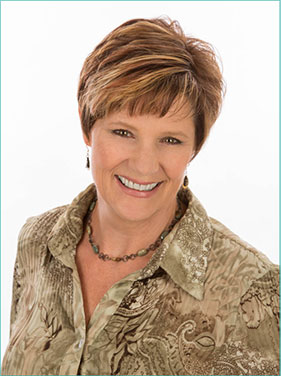
Susan Hasty is the CEO of 360 Profit Masters and the host of the Lucrative Leadership Conversations podcast. Susan considers herself a “maverick leader” on a mission to inspire and equip leaders to ignite their leadership genius. Susan co-founded 7 business ventures over the last 35 years. Her passion is helping business owners and CEOs improve their own clarity, focus and commitment to build more sustainable organizations empowered to make economic liberty a reality. She is certified in Neurolinguistic Programming and is a Strategic HR Business Partner by the Human Capital Institute. She is a member of the Marshall Goldsmith Stakeholder Centered Coaching Network of International Leadership coaches.
Ready to your business more profitable? Schedule a free call with Susan Hasty
GENE MORTON
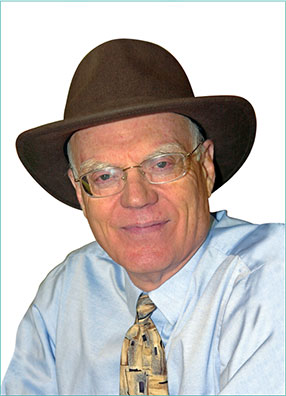 Gene Morton is an organizational psychologist based out of Colorado. He is also an award winning author of the book, Leaders First: Six Bold Steps to Sustain Breakthroughs in Construction. Over the past 40 years, Gene has consulted on more than 100 projects in 85 organizations with leader groups engaged in complex mergers, reorganizations, leadership turnarounds, and system redesigns.
Gene Morton is an organizational psychologist based out of Colorado. He is also an award winning author of the book, Leaders First: Six Bold Steps to Sustain Breakthroughs in Construction. Over the past 40 years, Gene has consulted on more than 100 projects in 85 organizations with leader groups engaged in complex mergers, reorganizations, leadership turnarounds, and system redesigns.
He developed the Leaders First Alignment Process to provide leadership teams the model they need to gain clarity as the organization evolves. His passion is mastering the complexities of organized and collaborative leadership.
Connect With Us
Subscribe to itunes Subscribe to stitcher Subscribe to Google Play
Straight forward leadership advice
Learn a simpler, more practical approach to building your leadership team strength... Delivered straight to your inbox!

